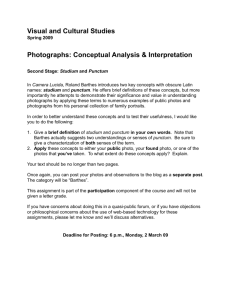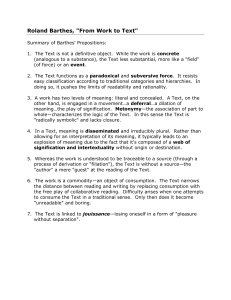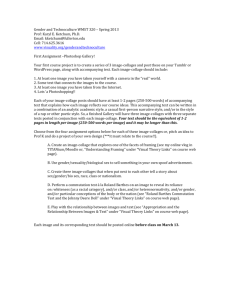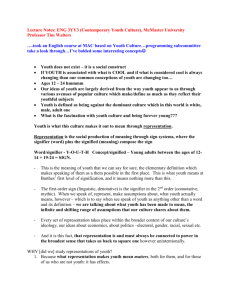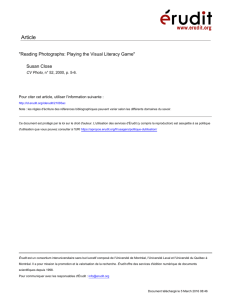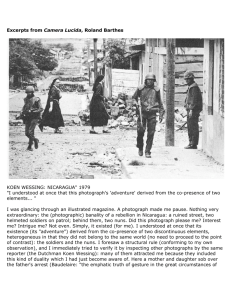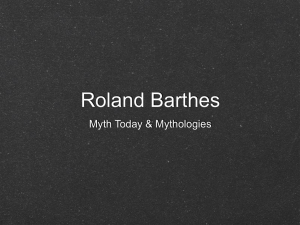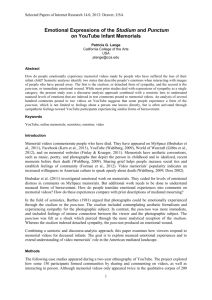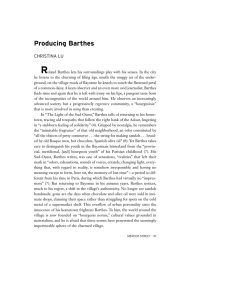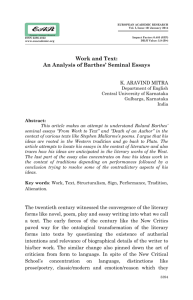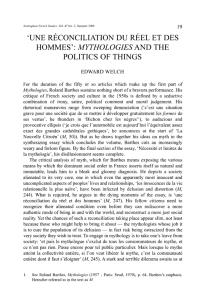Response 2 - Georgetown Digital Commons
advertisement
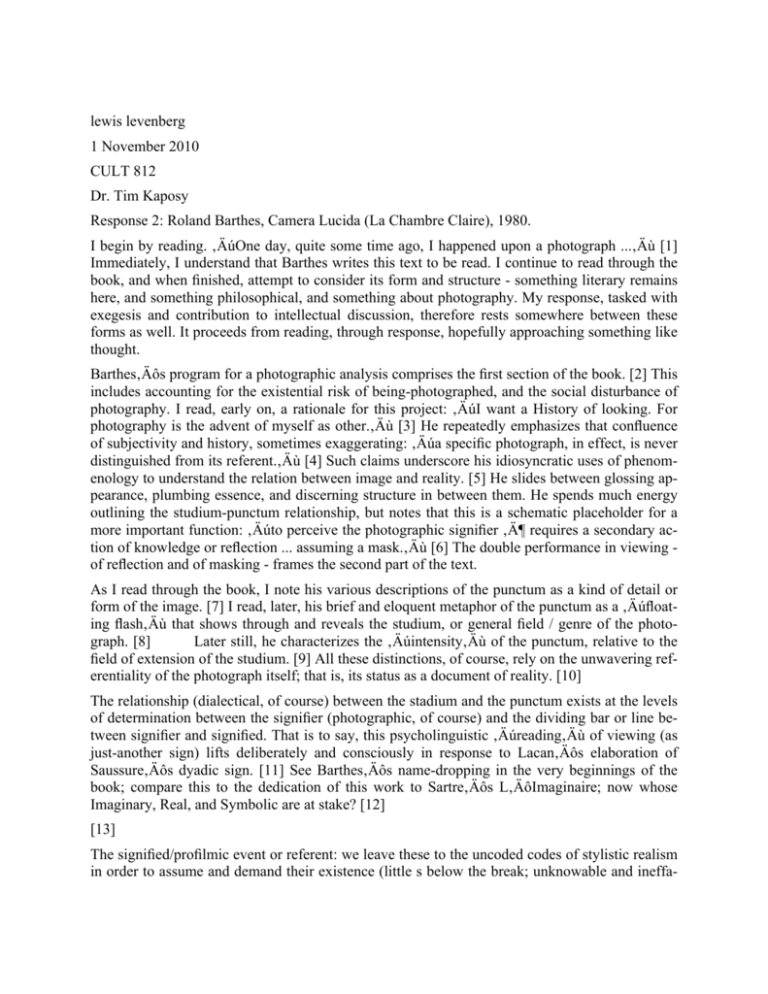
lewis levenberg 1 November 2010 CULT 812 Dr. Tim Kaposy Response 2: Roland Barthes, Camera Lucida (La Chambre Claire), 1980. I begin by reading. “One day, quite some time ago, I happened upon a photograph ...” [1] Immediately, I understand that Barthes writes this text to be read. I continue to read through the book, and when finished, attempt to consider its form and structure - something literary remains here, and something philosophical, and something about photography. My response, tasked with exegesis and contribution to intellectual discussion, therefore rests somewhere between these forms as well. It proceeds from reading, through response, hopefully approaching something like thought. Barthes’s program for a photographic analysis comprises the first section of the book. [2] This includes accounting for the existential risk of being-photographed, and the social disturbance of photography. I read, early on, a rationale for this project: “I want a History of looking. For photography is the advent of myself as other.” [3] He repeatedly emphasizes that confluence of subjectivity and history, sometimes exaggerating: “a specific photograph, in effect, is never distinguished from its referent.” [4] Such claims underscore his idiosyncratic uses of phenomenology to understand the relation between image and reality. [5] He slides between glossing appearance, plumbing essence, and discerning structure in between them. He spends much energy outlining the studium-punctum relationship, but notes that this is a schematic placeholder for a more important function: “to perceive the photographic signifier … requires a secondary action of knowledge or reflection ... assuming a mask.” [6] The double performance in viewing of reflection and of masking - frames the second part of the text. As I read through the book, I note his various descriptions of the punctum as a kind of detail or form of the image. [7] I read, later, his brief and eloquent metaphor of the punctum as a “floating flash” that shows through and reveals the studium, or general field / genre of the photograph. [8] Later still, he characterizes the “intensity” of the punctum, relative to the field of extension of the studium. [9] All these distinctions, of course, rely on the unwavering referentiality of the photograph itself; that is, its status as a document of reality. [10] The relationship (dialectical, of course) between the stadium and the punctum exists at the levels of determination between the signifier (photographic, of course) and the dividing bar or line between signifier and signified. That is to say, this psycholinguistic “reading” of viewing (as just-another sign) lifts deliberately and consciously in response to Lacan’s elaboration of Saussure’s dyadic sign. [11] See Barthes’s name-dropping in the very beginnings of the book; compare this to the dedication of this work to Sartre’s L’Imaginaire; now whose Imaginary, Real, and Symbolic are at stake? [12] [13] The signified/profilmic event or referent: we leave these to the uncoded codes of stylistic realism in order to assume and demand their existence (little s below the break; unknowable and ineffa- ble and all the same necessary Real). But the peculiar deconstruction of signification itself relies upon the distinction and mutual constitution between studium and punctum – so the concept envelopes, it does not just expose. As Barthes has it, the punctum breaks (punctures) the studium: understand the line dividing S from s as this break. In this case, turn it ninety degrees in any plane. Either the division then punctures signifier and signified at once, or viewer and sign at once (so, note the punctum as an affective wound.) The moment of feeling or observing the break, then, marks the moment at which the viewer becomes aware that they see both what-is-there and what-was-‘there’, i.e., before the film, the profilmic event in history. The coded studium, realm of cultural spectatorship, breaks intention into material structures, and extensive content. Meanwhile, the uncoded punctum, moment of essential accidence, breaks affect into detail and time. Thus, historicity reveals and constitutes the material affect. The practices of viewing photography, then, hinge on ecstasy and reality; or rather, upon the viewer’s assumption of these modes. Bracket spectacle, bracket capital, and extend the dyadic relationship into Barthes’s imagination. The significance of the operator in their material and historical specificity enters again, despite his best efforts to exclude it. In this way, as the critiques supplied by Fried and Elkins explain in greater detail, the development of photography beyond the subjective document, in medium and scope, seriously complicate the concepts sketched by Barthes. [14] So, does it work? What photography, literature, or analysis does his text produce for us? The reflexive recognition of the that-was and that-is functions [of recognition] remain. Still, in viewing even documentary images, and given advances in the cognitive and neuropsychological (eidetic) sciences, with their intense and technical explanation of vision itself, one must question the embedded but unexpressed historical-materialist mode of analysis undergirding Barthes’s invocation of phenomenology. Further, in just-reading his evocative argumentation, and the lucid, personal, reflexive prose-itself of the book-itself (as literature, the very “archaic trace” of “witness” beyond dry or mere theory), we must re-think what images we can think through text. Towards the end, Barthes invokes the limitations of his project: “no doubt, the astonishment of ‘that-has-been’ will disappear. I am, I don’t know why, one of its last witnesses (a witness of the Inactual), and this book is its archaic trace.” [15] He laments the lack of a gaze (privilege retains the power to force a forgetting of embodied positions): “oh, if only there were a Look, a subject’s look … !” [16] Finally, he stakes broader claims than a science or method for reading images: “Society is concerned to tame the photograph” from its wildness and violence, either by making it into Art, or by making it banal. [17] At this reading, I imagine (in lieu of thinking) the fulfillment of both of these possibilities simultaneously. ________________ [1]Barthes, R. Camera Lucida. 1980. p. 3 [2]ibid. part I, pp. 1-60 [3]ibid, pp. 11-12 [4]ibid, p. 5, cf. 30 [5]ibid, p. 20 [6]ibid, p. 34 [7]ibid, pp. 21-30 [8]ibid, p. 53 [9]ibid, p. 96 [10]ibid, pp. 76-77 [11]cf. Saussure, F., Course in General Linguistics, 1916; Benveniste, E., Problems in General Linguistics, 1939. Lacan, J., Ecrits, 1954. [12]Barthes, p. 1 [13]image from Chandler, D., Semiotics for Beginners: http://www.aber.ac.uk/media/Documents/S4B/Images/lacan.gif [14]cf. Fried, Barthes’s Punctum; Elkins, What do we Want Photography to Do? [15]Barthes, p. 94 [16]ibid, p. 111 [17]ibid, p. 117
